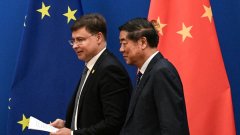
Southeast Asian Wall capital
Five of the 2022 series
The 'Electric Vehicle Revolution' in Southeast Asia is ready to go, whether it is the governments of Southeast Asian countries or car dealers in various countries, they are stepping up the accelerated layout of this emerging market full of business opportunities. Can Chinese car companies overtaking during this electric vehicle layout battle to break the market in Japan and South Korea and the European and American car brands?In the road of the Southeast Asian electric vehicle market, what kinds of campaigns still need to be crossed?
Buying a car for many middle -class families is an expense that must be carefully considered. Lin Mingde (32 years old, recruiter), who has increasing demand for a family of four.He bought the first Chinese brand electric vehicle in his life after the "Sangu Automobile Exhibition Room" earlier this year, becoming a niche in the Singapore car market.
The Southeast Asian electric vehicle market is about to enter a high -speed development period. According to the market research company Mordor Intelligence, the electric vehicle market in the Asian Diandan country is nearly 500 million US dollars (about S $ 690 million) in 2021, and will increase by more than four by 2027 by 2027Times, exceeding $ 2.6 billion.
However, this emerging market is still in the budding stage.Based on the data of the Singapore Land Transportation Administration, as of May this year, only about six of Singapore's private cars in Singapore are pure electric vehicles.
Among Singapore's registered private cars, there are currently three brands related to Chinese car companies, including BYD (BYD), the MG (MG) of SAIC Group, and the POLESTAR jointly created by Geely and Volvo.EssenceAs of December last year, these three brands have only 0.014 % of the newly -registered non -fuel and non -diesel cars, with a total of 228 vehicles.
Although the local electric vehicle market is small, the market growth rate has accelerated significantly in the past three years.The number of local pure electric vehicles stagnated from individual and double digits from 2011 to 2016, but began to break through in 2019. It has increased rapidly in the past six months. From 2942 vehicles in December last year, increased to 4054 in May this year.Vehicle.
cooperate with the local institution to set up a Chinese car company to establish a brand awareness
Chinese car companies have seen business opportunities eight years ago and laid seeds in the Singapore electric vehicle market.The Singapore Institute of Science and Technology (A*STAR) announced in 2014 that it signed a joint laboratory agreement with BYD to jointly develop an electric vehicle system for Singapore's public transportation; in 2016, the GO AHEAD bus group used BYD's electric bus to test;In 2017, the first all -electric Tex team using BYD started running on the Singapore Highway.
Since the beginning of this year, China Enterprise has accelerated its layout in the local electric vehicle market. After Weilai Automobile was listed on the Singapore Stock Exchange last month, it announced that it would set up an artificial intelligence and autonomous driving research and development center in Singapore.China Shenzhen Railway Company and SMRT's subsidiary Strides Mobility announced in April this year that the joint venture was established.
Chinese car companies have tried to seize the opportunity in the Singapore's electric vehicle market. One of the motivations is to establish a brand awareness in the field of electric vehicles and break the Japanese and European and American cars.
Lin Mingde originally had a Nissan fuel vehicle. He first came into contact with the Chinese brand's electric vehicle three years ago through the electric car, which changed the impression of Chinese car brands.
Scholars: Starting from Singapore as the target of Chinese car companies to lock the Southeast Asian market
Lin Mingde accepted a joint morning newspaper and said that his father -in -law began to use the Chinese brand's electric Dezai passengers three years ago. At that time, he found that the quality of Chinese cars was not as bad as he imagined, and his performance and safety were comparable to Japan, South Korea, and Europe and the United States.Brand; good impression of Chinese electric vehicles has deeply affected his car purchase decision earlier this year.
He said: "In Singapore, the evaluation of Chinese brands of electric vehicles is relatively small, so I was still cautious when I chose. When I bought the Nissan fuel car, I only went to the exhibition room once; this time I left, I leftThree exhibition rooms and test drives twice before deciding to buy Chinese brands. "
The analysis of scholars interviewees is that the ultimate goal of Chinese car companies is the Southeast Asian electric vehicle market with huge potential. Singapore is just the starting point and radiation point in this electric vehicle market battle.
Dr. Tan Xiaoyan, a senior researcher at the Viser -East South South Asian Research Institute, pointed out that Chinese car companies can use Singapore as a "test platform" to test the models they plan to launch in this area.
Walter Theseira, deputy professor of business school of Xinyue Social Sciences, pointed out that Singapore is regarded as an advanced international city in Southeast Asia and has brand effects.
Tesla said that in Southeast Asia, Singapore also has a leading position in public policy innovation. It can play a certain role in promoting the electric vehicle policy in the region.process.Another more practical consideration is that electric vehicles are generally aimed at mid -to -high -end markets, and currently only Singapore's consumption level is in line with this market.
However, Tesla emphasized that larger Southeast Asian countries such as Indonesia and Thailand are the real competitions of car companies.
BYD responded to this newspaper inquiries that Singapore, as a highly developed economy, has a great influence in Southeast Asia. It is a key market for Chinese car companies that want to enter the Southeast Asian market.In addition, Singapore also pays attention to environmental protection and has the good market environment and potential of new energy vehicles.
car companies in various countries in various countries
The newly -built electric car manufacturers in Indonesia in Indonesia have begun to be fully produced this year.Swedish brand Volvo announced in March this year that it was assembled in Malaysia.Germany's Marseille -Benz Group plans to start assembly electric vehicles in Thailand this year.
The Chunghwa Daily of Thailand reported in September last year that Chinese car companies such as SAIC Group, Great Wall Motors, Chery, Dongfeng, Geely and Changan will launch new models in Thailand.
The Malaysian company Fieldman announced the cooperation with China Changan Automobile at the beginning of the year, investing in RM1 billion (about S $ 322 million) to produce electric vehicles in Malacca.
Geely acquired the Malaysian car brand Baoto in 2017, and currently has 27 sales outlets in the Philippines.It is understood that Geely's Philippine sales outlets expected to be expanded to 40 at the end of this year, and then it will reach the same level as Japanese car brands such as Toyota, Mitsubishi, Honda.
Tan Xiaoyan pointed out that although Japanese and Korean and European and American brands have occupied the fuel vehicle market in Southeast Asia, But the electric vehicle market has not yet penetrated.These companies have paid huge sunk costs on fuel vehicle production facilities, so they tend to continue to use existing facilities to produce fuel vehicles.This provides opportunities for young car companies in China and other countries to enter the Southeast Asian market and set up electric vehicle factories in Southeast Asia. These new companies do not have to wait for the old fuel vehicle factories to gradually be eliminated.
(the development of Chinese consumer goods facing generations in this series in Southeast Asia)
Slow regional energy transformation or exacerbation of environmental pollution
Electric vehicle transformation is generally regarded as an important engine of clean energy transformation, but some environmentalists worry that Southeast Asia's clean energy transformation cannot keep up with the development speed of electric vehicles, and may even exacerbate environmental problems caused by nickel mining.
Nickel is the key raw material for manufacturing electric vehicle batteries. Indonesia and the Philippines are the world's first and second -largest nickel ore producers; Indonesia alone accounts for 37 % of the global nickel ore output.
Southeast Asia's promoting electric vehicle development is mainly due to economic considerations
Over the past three years, environmental problems caused by nickel mining in Indonesia have attracted great attention from environmental protection groups.The report released by Ecological and People's Liberation (AEER) pointed out at the beginning of the year that the water sources of the Indonesian Islands are polluted due to nickel mining projects, and the water source that residents rely on relying on their lives are measured.In 2019, Kendari, the capital of Southeast Southawesi Province, once broke out of violent protests against the nickel industry.
Power in many countries in Southeast Asia currently depends on traditional energy. Tata Mustasya, the climate and energy initiative of Green Heping Indonesia, pointed out that 58 % of Indonesia in Indonesia, the largest population of Asian, comes from coal.
Tata said that the development of electric vehicles in Southeast Asian countries is mainly due to economic considerations, and energy transformation is only secondary.If Southeast Asia wants to truly achieve the development of electric vehicles in the environment, energy transformation must be handled hand in hand, otherwise the use of electric vehicles will only turn the carbon emissions in the transportation field to the power field.
Singapore Yusov Isa Easa East South Asia Senior Researcher and the coordinator of the Asia Innoid Research Center, Li Lilian pointed out that the transformation of electric vehicles in Southeast Asia is noticeable, but if it does not cooperate with energy transformation, this is only a surface change;Electric power is the original intention of electric vehicle to charge for electric vehicles.
If Southeast Asia wants to truly achieve the development of electric vehicles in the environment, energy transformation must be handled hand in hand, otherwise the use of electric vehicles will increase, and the carbon emissions in the transportation field will only be transferred to the power field.
—— Green Peace Indonesia Branch
Tota of Climate and Energy Initiative
The price of Chinese electric vehicles is a double -edged sword
Low price is the biggest advantage of Chinese electric vehicles, but it may also cause Chinese car companies to fall into dilemma in the high -end market battle.
According to the British media Autocar, in the past 10 years, the price of electric vehicles in Europe has risen by 28 %, but China's electric vehicle prices have fallen by 47 %; as of 2021, the average price of electric vehicles in Europe was more than 7,20,000 yuan.The average price of Chinese electric vehicles is only over 37,000 yuan.
Chinese car companies can focus on establishing cooperation with private car companies
Alloysius Joko Purwanto, an East Asian Institute of Economic Research Institute, believes that the lower price of Chinese electric vehicles is the biggest advantage.Chinese cars should focus on the establishment of cooperation with private car companies. If Chinese car companies can prove that their electric vehicles are safe and reliable, they are expected to truly go hand in hand with Japanese and Korean and European cars giants.
But under the circumstances of the shortage of electric vehicle raw materials such as lithium, nickel (Nickel) and cobalt (COBALT), some analysts believe that Chinese car companies may be more inclined to enter the high -end market in Southeast Asia abroad.Become a double -edged sword.
Tesla, an associate professor of the Business School of Xinyue Social Sciences, pointed out that Southeast Asia's overall consumption level is low, and the largest electric vehicle market vacancy is in the mass market with a lower price. This is also China's most advantageous market.However, car companies in various countries should focus on high -end markets in order to obtain higher profits.In addition to the domestic market, global car companies are not interested in the low -end electric vehicle market.
Tesla's judgment, in addition to the Volkswagen market, the electric motorcycle market is also an area where China has great advantages.Chinese electric motorcycle giants have begun to enter Indonesia, Vietnam and other Southeast Asian countries in 2020.However, Tesla pointed out that consumers of electric cycling are more sensitive to prices. How to maintain competitive prices in the case of scarce raw materials will become a greater problem.
Southeast Asia's electric vehicle market is developing slowly
Governments of Southeast Asian governments have increased their horsepower in the past three years, attracting promotion for the electric vehicle market and expanding the use of electric vehicles, but Southeast Asian consumers have been transformed slowly. As of last year, electric vehicles in the Southeast Asian market only reached a contract with a contract.1%.
Thailand, which ranked first in Southeast Asia's car output, has set a target in 2020. It will increase the production of electric vehicle to 30 % of the total national automobile output in 2030; last March, the goal further increased to 50 %.In February of this year, the Thai government launched electric vehicle support measures, including lowered some import tariffs and consumption taxes, as well as market subsidies.
Indonesia promulgated the presidential regulations in 2019, indicating that it is necessary to give priority to the development of domestic facilities for manufacturing electric vehicles and related parts.Last year, Indonesia set up a state -owned enterprise called PT Industri Baterai Indonesia (IBI) to support international companies' electric vehicle raw materials investment in Indonesia.Indonesian President Zoko also proposed in February that the goal of achieving 200 million vehicles in electric vehicle roads in 2025.
However, according to the automotive media JustATO, Indonesia's first five months of electric vehicles has sold less than 400 vehicles.
Malaysia launched a new electric vehicle support plan in January this year, including exemption of all imports and consumption taxes for imported electric vehicles, and exempting highway taxes for electric car owners and providing personal tax rebates.Singapore's electric vehicle additional registration fee preferential plan came into effect in January last year.




